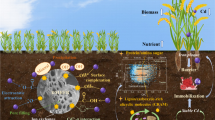Abstract
Bioleaching of sulfide minerals by bacteria, mainly Thiobacillus ferrooxidans (T. f.) and Thiobacillus thiooxidans, plays an important role in hydrometallurgy because of its economic and environmental attractions. The surveys of production process and the bacterial oxidation activity in the heap bioleaching were investigated. The results show that pH value is high, bacteria biomass and ferric concentration are low, generation time (above 7.13 h) is long in leachate, and less bacteria are adsorbed on the ores. The bacteria in the leachate exposing on the surface and connecting with mineral, have much faster oxidation rate of Fe(II) and shorter generation time, compared with those which are in the reservoir for a long time. There is diversity for oxidation activity of Fe(II), while there is no diversity for oxidation of sulfur. So it is advisable to add sulfuric acid to degrade pH value to 2.0, add nutrients and shorten recycling time of leachate, so as to enhance bacteria concentration of leachate and the leaching efficiency.
Similar content being viewed by others
References
FNAG Jin-wei, LI Wei-zhong. Summary of development and application of coper extractive[J]. Nonferrous Metal Smelt, 1999, 28(2): 30–32. (in Chinese)
YANG Song-rong, XIE Ji-yuan, QIU Guan-zhou, et al. Research and application of bioleaching and biooxidation technologies in China[J]. Minerals Engineering, 2002, 22(5): 361–363.
SHEN Ping, FAN Xiu-rong, LI Guang-wu. Microbiology Practice[M]. Beijing: Higher Education Press, 2001. 90–92. (in Chinese)
ZHANG Dong-yan. Separation of strain of Thiobacillus Ferrooxidans (C-1#) and research on its specialties [J]. J Inner Mongolia Univ Technol, 1995, 14(1): 27–30. (in Chinese)
LIU Jian-she, QIU Guan-zhou, HU Yue-hua. Kinetics of electrochemical corrosion of chalcopyrite in presence of bacteria[J]. Trans Nonferrous Met Soc China, 2000, 10(Special): 68–70.
Cabral T, Ignatiadis I. Mechanistic study of the pyrite-solution interface during the oxidative bacterial dissolution of pyrite (FeS2) by using electrochemical techniques[J]. Int J Miner Process, 2001, 62(1–4): 41–64.
QIU Guan-zhou, LIU Jian-she, WANG Dian-zuo. Iron behaviour in growth of Thiobacillus ferrooxidans [J]. J Cent South Univ Technol (Natural Science), 1998, 29(3): 226–228. (in Chinese)
LIU Jian-she, QIU Guan-zhou, WANG Dian-zuo. Bacteria leaching mechanism on ores sulfide[J]. Hydrometallurgy, 1997, 63(3): 1–3. (in Chinese)
Bosecker K. Bioleaching: metal solubilization by microorganisms[J]. FEMS Microbiology Revies, 1997, 20(3–4): 591–604.
REN Zi-ping, YANG Zan-zhong. The environmental protection function of minerals and its application perspective[J]. Conservation and Utilization of Mineral Resources, 2001, 3(1): 44–48. (in Chinese)
ZHANG Zai-hai. The Screening and Breeding of High Effective Bacteria and Mechanism of Copper Sulfide Minerals[D]. Changsha: Central South University, 2002. (in Chinese)
Tyagi R D, Couillard D, Grenier Y. Effects of medium composition on the bacterial leaching of metals from digested sludge[J]. Environ Pollut, 1991, 71(1): 57–67.
Suzuki I. Microbial leaching of metals from sulfide minerals[J]. Biotechnology Advances, 2001, 19(2): 119–132.
Walton K C, Johnson D B. Microbiological and chemical characteristics of acidic stream draining a disused copper mine[J]. Environ Pollut, 1992, 76(2): 169–175.
Fournier D, Lemieux R, Couillard D. Essential interactions between Thiobacillus ferrooxidans and heterotrophic microorganisms during a wastewater sludge bioleaching process[J]. Environ Pollut, 1998, 101(2): 303–309.
Author information
Authors and Affiliations
Corresponding author
Additional information
Foundation item: Project (50321402) supported by China Science Fund for Distinguished Grop; project (50374075) supported by the National Natural Science Foundation of China
Rights and permissions
About this article
Cite this article
Liu, Js., Xia, Hb., Wang, Zh. et al. Bacterial oxidation activity in heap leaching. J Cent. South Univ. Technol. 11, 375–379 (2004). https://doi.org/10.1007/s11771-004-0078-2
Received:
Accepted:
Published:
Issue Date:
DOI: https://doi.org/10.1007/s11771-004-0078-2




